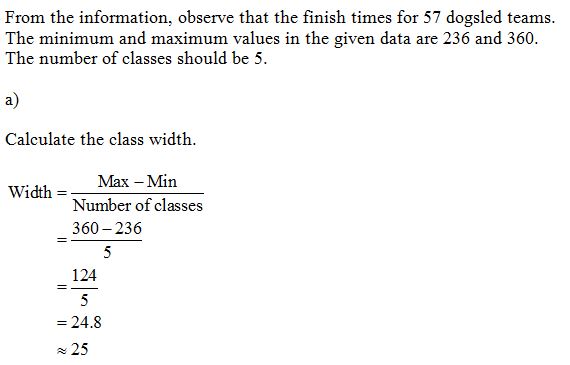How long does it take to finish the 1161-mile Iditarod Dog Sled Race from Anchorage to Nome, Alaska? Finish times (to the nearest hour) for 57 dogsled teams are shown below. 261 271 236 244 279 296 284 299 288 288 247 256 338 360 341 333 261 266 287 296 313 311 307 307 299 303 277 283 304 305 288 290 288 289 297 299 332 330 309 328 307 328 285 291 295 298 306 315 310 318 318 320 333 321 323 324 327 USE SALT
How long does it take to finish the 1161-mile Iditarod Dog Sled Race from Anchorage to Nome, Alaska? Finish times (to the nearest hour) for 57 dogsled teams are shown below. 261 271 236 244 279 296 284 299 288 288 247 256 338 360 341 333 261 266 287 296 313 311 307 307 299 303 277 283 304 305 288 290 288 289 297 299 332 330 309 328 307 328 285 291 295 298 306 315 310 318 318 320 333 321 323 324 327 USE SALT
MATLAB: An Introduction with Applications
6th Edition
ISBN:9781119256830
Author:Amos Gilat
Publisher:Amos Gilat
Chapter1: Starting With Matlab
Section: Chapter Questions
Problem 1P
Related questions
Question

Transcribed Image Text:How long does it take to finish the 1161-mile Iditarod Dog Sled Race from Anchorage to Nome, Alaska? Finish times (to the nearest
hour) for 57 dogsled teams are shown below.
261 271 236 244 279 296 284 299 288
288 247 256 338 360 341 333 261 266
287 296 313 311 307 307 299 303 277
283 304 305 288 290 288 289 297 299
332 330 309 328 307 328 285 291 295
298 306 315 310 318 318 320 333 321
323 324 327
USE SALT
For this problem, use five classes.
(a) Find the class width.
25
236
261
286
311
336
(b) Make a frequency table showing class limits, class boundaries, midpoints, frequencies, relative frequencies, and cumulative
frequencies. (Round your relative frequencies to two decimal places.)
Class Limits
Class Boundaries Midpoint Frequency
I
I
I
-
260
285
310
335
360
-
Relative Cumulative
Frequency Frequency
Expert Solution
Step 1

Step by step
Solved in 2 steps with 2 images

Recommended textbooks for you

MATLAB: An Introduction with Applications
Statistics
ISBN:
9781119256830
Author:
Amos Gilat
Publisher:
John Wiley & Sons Inc

Probability and Statistics for Engineering and th…
Statistics
ISBN:
9781305251809
Author:
Jay L. Devore
Publisher:
Cengage Learning

Statistics for The Behavioral Sciences (MindTap C…
Statistics
ISBN:
9781305504912
Author:
Frederick J Gravetter, Larry B. Wallnau
Publisher:
Cengage Learning

MATLAB: An Introduction with Applications
Statistics
ISBN:
9781119256830
Author:
Amos Gilat
Publisher:
John Wiley & Sons Inc

Probability and Statistics for Engineering and th…
Statistics
ISBN:
9781305251809
Author:
Jay L. Devore
Publisher:
Cengage Learning

Statistics for The Behavioral Sciences (MindTap C…
Statistics
ISBN:
9781305504912
Author:
Frederick J Gravetter, Larry B. Wallnau
Publisher:
Cengage Learning

Elementary Statistics: Picturing the World (7th E…
Statistics
ISBN:
9780134683416
Author:
Ron Larson, Betsy Farber
Publisher:
PEARSON

The Basic Practice of Statistics
Statistics
ISBN:
9781319042578
Author:
David S. Moore, William I. Notz, Michael A. Fligner
Publisher:
W. H. Freeman

Introduction to the Practice of Statistics
Statistics
ISBN:
9781319013387
Author:
David S. Moore, George P. McCabe, Bruce A. Craig
Publisher:
W. H. Freeman